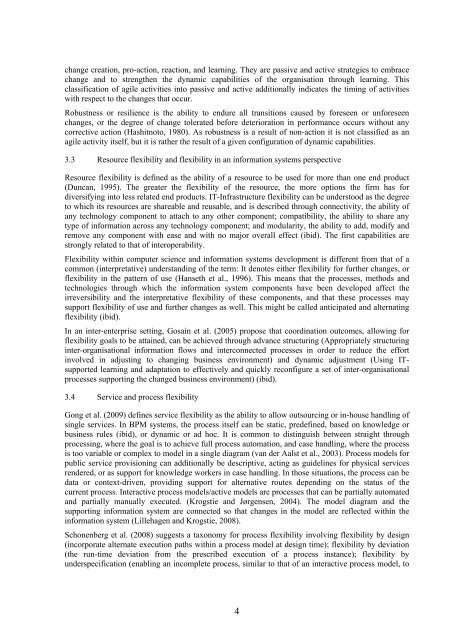Multi-channel provisioning of public services - Department of ...
Multi-channel provisioning of public services - Department of ...
Multi-channel provisioning of public services - Department of ...
You also want an ePaper? Increase the reach of your titles
YUMPU automatically turns print PDFs into web optimized ePapers that Google loves.
change creation, pro-action, reaction, and learning. They are passive and active strategies to embrace<br />
change and to strengthen the dynamic capabilities <strong>of</strong> the organisation through learning. This<br />
classification <strong>of</strong> agile activities into passive and active additionally indicates the timing <strong>of</strong> activities<br />
with respect to the changes that occur.<br />
Robustness or resilience is the ability to endure all transitions caused by foreseen or unforeseen<br />
changes, or the degree <strong>of</strong> change tolerated before deterioration in performance occurs without any<br />
corrective action (Hashitnoto, 1980). As robustness is a result <strong>of</strong> non-action it is not classified as an<br />
agile activity itself, but it is rather the result <strong>of</strong> a given configuration <strong>of</strong> dynamic capabilities.<br />
3.3 Resource flexibility and flexibility in an information systems perspective<br />
Resource flexibility is defined as the ability <strong>of</strong> a resource to be used for more than one end product<br />
(Duncan, 1995). The greater the flexibility <strong>of</strong> the resource, the more options the firm has for<br />
diversifying into less related end products. IT-Infrastructure flexibility can be understood as the degree<br />
to which its resources are shareable and reusable, and is described through connectivity, the ability <strong>of</strong><br />
any technology component to attach to any other component; compatibility, the ability to share any<br />
type <strong>of</strong> information across any technology component; and modularity, the ability to add, modify and<br />
remove any component with ease and with no major overall effect (ibid). The first capabilities are<br />
strongly related to that <strong>of</strong> interoperability.<br />
Flexibility within computer science and information systems development is different from that <strong>of</strong> a<br />
common (interpretative) understanding <strong>of</strong> the term: It denotes either flexibility for further changes, or<br />
flexibility in the pattern <strong>of</strong> use (Hanseth et al., 1996). This means that the processes, methods and<br />
technologies through which the information system components have been developed affect the<br />
irreversibility and the interpretative flexibility <strong>of</strong> these components, and that these processes may<br />
support flexibility <strong>of</strong> use and further changes as well. This might be called anticipated and alternating<br />
flexibility (ibid).<br />
In an inter-enterprise setting, Gosain et al. (2005) propose that coordination outcomes, allowing for<br />
flexibility goals to be attained, can be achieved through advance structuring (Appropriately structuring<br />
inter-organisational information flows and interconnected processes in order to reduce the effort<br />
involved in adjusting to changing business environment) and dynamic adjustment (Using ITsupported<br />
learning and adaptation to effectively and quickly reconfigure a set <strong>of</strong> inter-organisational<br />
processes supporting the changed business environment) (ibid).<br />
3.4 Service and process flexibility<br />
Gong et al. (2009) defines service flexibility as the ability to allow outsourcing or in-house handling <strong>of</strong><br />
single <strong>services</strong>. In BPM systems, the process itself can be static, predefined, based on knowledge or<br />
business rules (ibid), or dynamic or ad hoc. It is common to distinguish between straight through<br />
processing, where the goal is to achieve full process automation, and case handling, where the process<br />
is too variable or complex to model in a single diagram (van der Aalst et al., 2003). Process models for<br />
<strong>public</strong> service <strong>provisioning</strong> can additionally be descriptive, acting as guidelines for physical <strong>services</strong><br />
rendered, or as support for knowledge workers in case handling. In those situations, the process can be<br />
data or context-driven, providing support for alternative routes depending on the status <strong>of</strong> the<br />
current process. Interactive process models/active models are processes that can be partially automated<br />
and partially manually executed. (Krogstie and Jørgensen, 2004). The model diagram and the<br />
supporting information system are connected so that changes in the model are reflected within the<br />
information system (Lillehagen and Krogstie, 2008).<br />
Schonenberg et al. (2008) suggests a taxonomy for process flexibility involving flexibility by design<br />
(incorporate alternate execution paths within a process model at design time); flexibility by deviation<br />
(the run-time deviation from the prescribed execution <strong>of</strong> a process instance); flexibility by<br />
underspecification (enabling an incomplete process, similar to that <strong>of</strong> an interactive process model, to<br />
4
















